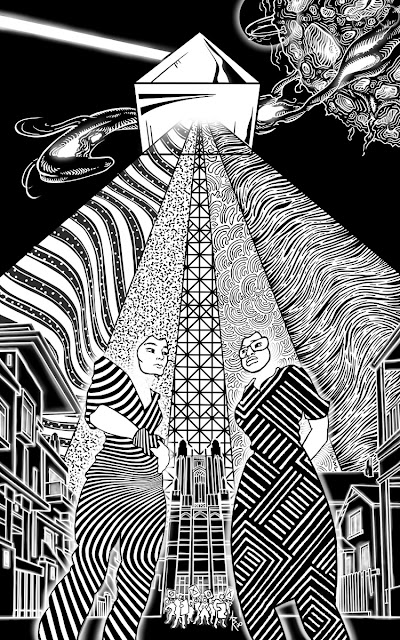The challenge was to illustrate in black and white a story about colors.
The story, published in Space and Time Magazine (#139,) is titled "interference," written by Leonard Speiser.
It's a tale of science fiction where the characters are living beings of electromagnetic energy who live and work with some of the same biases and inequality we see in our own world. As the colors begin integrating, the world changes and some characters handle this change better than others.
It's a solid work of writing, thoughtful, with good momentum. It's also the first story I've illustrated where I had contact with the author about the artwork prior to publication. This story was considered somewhat abstract when the art was commissioned. There was also the challenge of working without color. This led the publishers to connect me with the author who had already shared the idea of using a large prism casting down a spectrum of light to help visualize the nature of this world. The prism was easy to integrate and, I feel, very effective. But this illustration was also the first time I had to worry about the possibility of disappointing an author, as I was unable to deliver on part of the vision he shared with me.
In his emails the author described how he pictured the characters as beings of energy, humanoid in shape but perhaps missing key human features like hands or mouths. He was also very good to link to images online which included faceless beings of bespeckled light. So, of course, my first sketches included faceless forms. Unfortunately, I wrestled with the results and ultimately just couldn't get them to work.
Later I realized that the reason faceless characters weren't working visually was because the story had a strong character focus. If this had been a tale of adventure with energy beings blasting through space, fighting monsters and discovering new worlds as its focus, illustrating the faceless characters would have worked perfectly well. But with Speiser's tale I kept feeling that the weight of character relationships and the sober societal themes of the story required an emotional focus for the reader to attach to. So I kept the faces and erased the heads instead.
The challenge of how to communicate color in a black and white drawing was almost immediately solved when the author proposed the idea of the prism. I would just translate colors to textures and give the sense of contrasting hue. So spilling out in this spectrum there are flag-like wavy lines, coarse static, linear scaffolding (like train-tracks?), curly fibers, and muscle sinew.
The bodies of the characters are themselves made up of only texture, a twisted optical illusion of curves for one and a more traditional, artful pattern of lines for the other. In the story one of the characters is a third generation immigrant and I chose a pattern that is meant to reflect the beauty and culture she carries with her.
The author and I also coordinated a few Easter eggs into the piece. One is the building at the distance seen between the two characters. In the story, this is The Factory. But it's shape and detail come directly from two real buildings found on the Wellesley College campus in Massachusetts (namely the Tower Court building and the top of the Galen Stone Tower.) This was a nod to the author's wife who graduated from Wellesley and is herself a strong advocate in her community for equity and other noble causes.
Other inspirations for this illustration came from historic photos during the Civil Rights Movement, the science of prisms, 1980s shoulder glam, the lines of Fallingwater by F.L.W., and a tiny touch of The Grid from Tron.



If anyone can make a black and white illustration of colored light, it's you.
ReplyDeleteThank you, Angela, for believing in me.
Delete